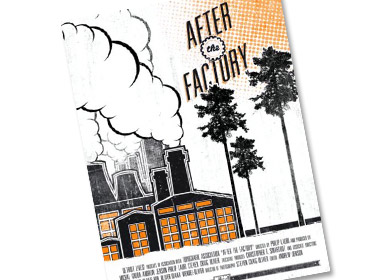A weird disorientation kicks in when you first watch After the Factory. Scenes of abandoned industrial buildings march by in quick succession, and, if you’ve spent much time in Easthampton or Holyoke, your brain starts to question: Was that Eastworks? Was that Open Square?
But no, it wasn’t either. The scenes of post-industrial decay come from Detroit and from Lodz, Poland. The rather stunning, immediate similarities certainly provide food for thought, and that’s in part why After the Factory arrives on a Holyoke screen this week.
The documentary may sound like a snoozefeste_SEmDit’s hard to imagine more stultifying subject matter than urban decay and post-industrial economics. All the same, the filmmakers, an outfit called Detroit Lives, do a superb job of taking the usual talking-head documentary and creating something far more dynamic. And all of that with very little of the Ken Burns effect of panning across still photos.
After the Factory places its talking-head subjects in interesting places, and usually frames them in different parts of the screen. Add to that a restless sense of editing, and you get a quick-paced mix-up of information, interesting visuals (who doesn’t love the play of light and debris in abandoned buildings?), and all sorts of people who live in Detroit and Lodz, plotting the next moves for these often written-off places.
The film’s only real weakness is that it almost inevitably lacks a cohesive narrative. People with big ideas and small show up to offer their impressions of the places where they live and talk about what they hope to do. It’s a mixed bag of ideas with no particular guiding principle, from large-scale things like transforming Lodz into a smartphone-friendly tourist zone to making Detroit’s massive blight into massive parks to small-scale but nonetheless important entrepreneurial undertakings like restaurants, clubs and art collectives.
In the end, though, it’s that very scattering of all those ideas that makes the film lively and useful. That’s especially true in Holyoke, a city that may be much smaller than Detroit or Lodz, but still stands to profit from the kinds of ideas these entrepreneurs, journalists and thinkers bring to the fore.
The artists and entrepreneurs of Holyoke ought to have plenty to talk about after After the Factory. The city was, after all, founded as a manufacturing center on grand scale, and many of the problems of Detroit and Lodz are but bigger versions of Holyoke’s challenges. In a city with a lot to gain and a lot to lose, the percolation of ideas stands to determine a lot about the flavor of Holyoke in the long-term.
That conversation is yet more important now, after Holyoke’s Eric Suher has announced his intention to pursue a quite different approach to transforming Holyoke with a casino at Mountain Park. Even casino fans ought to find plenty of ideas for revitalization among the inspiring and upbeat characters who talk up the virtues of forgotten Detroit and Lodz. Their visions of the future are multifaceted and exciting for their reliance on starting from the bottom up, for a city made over for and by its residents, rather than by some large-scale, all-pervasive intervention of the dubious sort a casino would bring.
After the film screening, you can bring your own ideas for Holyoke to the table in a discussion forum.•
After the Factory: Jan. 11, 6 p.m., MIFA, The Great Banking Hall, 56 Suffolk St., Holyoke, (800) 224-MIFA.



